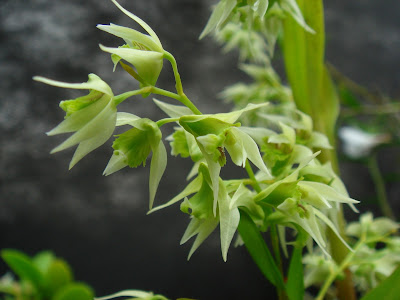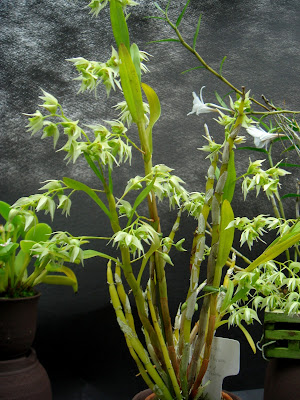Dendrobium eriiflorum is present in a very large area. Natural habitat includes central Nepal, India, Sikkim, Bhutan, Manipur and Khasi (Khasia) Hills, and Burma (Myanmar), Malaya and Sumbawa. The height of occurrence is 1000-2000m.
Dendrobium eriiflorum, also called as The Eria-Like Flowered Dendrobium, Callista eriiflora, Dendrobium eriaeflorum, Dendrobium eriiflorum var. lombokense, Dendrobium eriiflorum var. sikkimense, Dendrobium erleflorum, is a species of the genus Dendrobium. This species was described by William Griffiths in 1851.
IDENTIFY DENDROBIUM ERIIFLORUM
Dendrobium eriiflorum is present in a very large area. Natural habitat includes central Nepal, India, Sikkim, Bhutan, Manipur and Khasi (Khasia) Hills, and Burma (Myanmar), Malaya and Sumbawa. The height of occurrence is 1000-2000m. They are also found in Eastern Java, especially Mt. Arjuno, Mt.Wilis and Mt.Kelud, where it occurs at heights of 1200-1800 m.
It is a small sized, warm to cool growing epiphyte, which reaching 8-30 cm in height, with clustered, fleshy at the base, attenuate above, yellow, 5-25 cm long stems enveloped by loose sheaths and carrying up to 9, deciduous, oblong or lanceolate, obtuse, 4-13 cm long leaves.
The Eria-Like Flowered Dendrobium blooms in the late summer and fall on a erect to arching, 1.6 to 3.2" (4 to 8 cm) long, laxly, 6 to 8 flowered inflorescence with upside down flowers that open simultaneously. The flowers are 0.9-1.5 cm long. The flakes of both whorls, which do not open completely, have variable shades of yellow, white and green. The dorsal petal is long-lanceolate. Sharp-ended lateral outer petals are oval-triangular and slightly curved. The inner whorl flakes are almost lanceolate, wavy in 30% on the lower part and pulled off at the base. The yellowish lip and rod are milked and have delicate, purple spots. The middle plot of the lip is broad and wavy. The crested protuberance has 3 undulating green bulges.
DENDROBIUM ERIIFLORUM CARE AND CULTURE
Cultural information should only be used as a guide, and should be to be adapted to suit you. Your physical location; where you grow your plants, how much time you have to devote to their care, and many other factors, will need to be taken into account. Only then can you decide on the cultural methods that best suit you and your plants.
Light:
Dendrobium eriiflorum needs a light level of 25000-35000 lux. From autumn to spring, the intensity of light should be as high as possible, especially in the afternoon, so as not to burn the leaves.
Temperature:
The average temperature of the summer day is 24 ° C, night 17 ° C, giving a daily difference of 7 ° C. The average temperature of the winter day is 17-22 ° C, the night 2-4 ° C, giving a daily difference of 13-14 ° C.
Humidity:
In summer, The Eria-Like Flowered Dendrobium needs the humidity of almost 85%, but at the end of winter and at the beginning of spring it drops to 65-70%.
Substrate, growing media and repotting:
Dendrobium eriiflorum recommend a bark of fine to medium granulation with the addition of pearlite, which retains moisture. Repotting is best done in early spring, when new roots begin to grow.
Watering:
Water is abundant from spring through the summer, but in the autumn it drops sharply. Cultivated plants should be constantly moist during active growth, but the amount of water should be gradually reduced in autumn, when new increments reach maturity.
Fertilizer:
It is recommended to apply a 1/4-1/2 dose of orchid fertilizer weekly. From spring to mid-summer, high-nitrogen fertilizer should be used, and then until the end of autumn high-phosphoric fertilizer.
Rest period:
Dendrobium eriiflorum should survive even temperature drops below 0 ° C, if they are dry, but when cultivating such extreme conditions should be avoided. From late autumn to early spring, you should significantly reduce the amount of water and allow the plants to dry between watering, they can not stay dry for too long. Occasional fogging between waterings during periods of cloudless, sunny weather will protect the plants from excessive drying. Fertilization should be reduced or even eliminated until active growth increases in the spring and increases watering.















COMMENTS